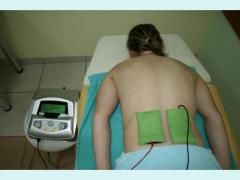
Electrotherapy
The electrotherapy is the discipline of physical therapy in which direct current or low and medium frequency pulse currents are used.
In our Centre we use the following types of currents for therapeutical use
1. Iontophoresis - being a non-invasive method of introducing to the tissue electric field forces acting as ion treatment.
The main indications for the use of iontophoresis are:
- Iodine iontophoresis: for the treatment of scars, cicatricial contractures
- Calcium iontophoresis: peripheral vasomotor disturbances
- Lidocaine iontophoresis: for the treatment of neuralgias, sciatica, headaches
- Histamine iontophoresis: for the treatment of chronic inflammatory states of joints and pariarthritis
2. LOW FREQUENCY CURRENTS – these are all low frequency currents of electric pulses with frequency 0,5 to 500 Hz.
There are three groups of them:
- Currents - composed of rectangular pulses are widely used for electro stimulation of muscles and nerves and for electro diagnosis. The stream composed of rectangular pulses, with duration of 2ms and 5ms break, causes tetanic contractions of skeletal muscle, and subsequently reduces muscle tension. Since it also works as analgesic, is used to treat the pains, muscle pain and degenerative joint disease.
- Currents - composed of triangular pulses are used for selective stimulation of muscles with flaccid paraplegia. In the course of treatment we have the opportunity to prevent muscular atrophy and maintain the largest ability to shrinkage of muscle mass until nerves are recreated. It can also improve the disadvantaged of the muscles groups. This goal is reached by increasing muscle mass and elimination of alternative movements that occur in paralysis and significantly impedes the improvement
- Currents generated in the result of sinusoidal current – straightening otherwise known as a diadynamic currents.
The indications for the use diadynamic currents are :
1. Pain complexes during the curse of spine bone joints degeneration :
- Pains of neck part of spine bone;
- Back and spine bone pains
- Sciatica
2. Neuralgias
- Shoulder plexus neuralgia
- Neuritis
- Neuralgia of trigeminal nerve
- Sciatica
3. Pariarthritis
- pariarthritis of arm joint
- pariarthritis of shoulder joint
- pariarthritis of joints
- joint, muscle and tendons injuries treatment
- peripheral paralysis of face nerve
- inactivity based muscular atrophy
Transcutaneous Electrical Nerve Stimulation (TENS) is the kind of stimulation used for the treatment of chronic pain.
1. Traditional TENS - high frequency current is used for the stimulation of thick – and medium thick nerve fibre – that is for closing of ‘gate’ to the pain transmission through thin nerve fibres
2. Low frequency TENS – this type of electro stimulation treats endorphin secretions
3. TENS Burst – that is better tolerated by a patient, analgesic effect persist for cca. 4 hours due to working of endorphins.
4. Brief Intense TENS – stimulation causes tetanic spasm and anaesthesia after 15 minutes
5. Modulated TENS – the modulation is causing the effect of the massage
MEDIUM FREQUENCY CURRENTS
In the recent years medium frequency currents – 4000 to 5000 Hz - are more often used. The point for their use is
- More gentle effect on contact receptors – the treatment is more sustainable for the patient
- Limited electrochemical influence on tissues – the risk of electrolytic injuries of skin is very low
- Currents are better transmitted into the tissue
0 – 10 Hz - induce contractions of muscles
25 – 50 Hz - intensive agitation of muscles for contractions and better peripheral circulation
50 – 100 Hz - generates analgesic effects and reduces the strain of sympathetic system
0 – 100 Hz - generates blood congestion in tissues, analgesic effect, improves of lymph circulation, nutritional processes and metabolism